
NATIVE AMERICANS and FIRST NATIONS
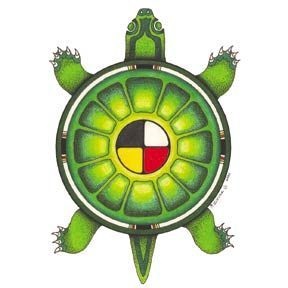
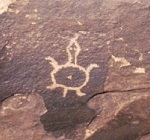
This page is one small part of Good Sites for Kids!
November is
Native
American Heritage Month

Battle
Where the Girl Saved Her Brother
A
Young Mother at the Rosebud and Little Bighorn Battles
Buffalo Calf Road Woman Wikipedia
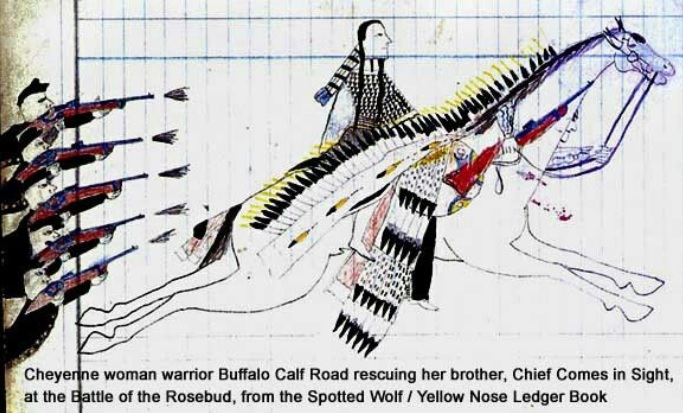

Petroglyph depicting whales, Qaqortoq, Greenland.
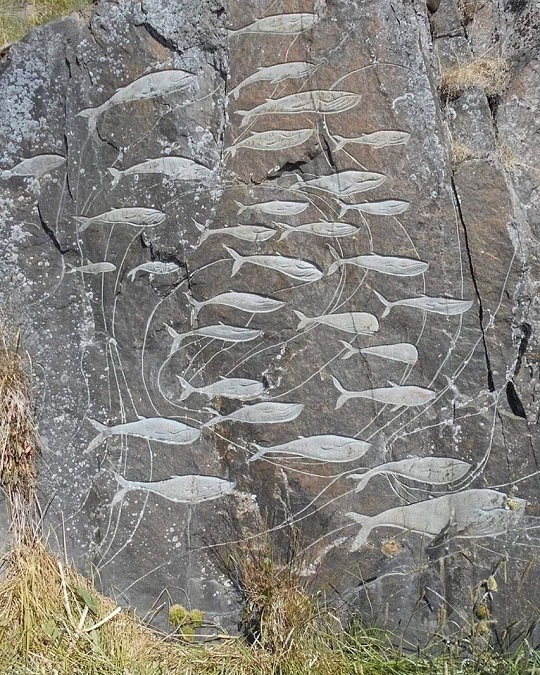
A
Gathering of Nations
Images from McKenney & Hall's History of the Indian
Tribes of North America. Part of the University of Cincinatti
collection, powered by JSTOR.Also includes many portraits
from George Catlin: The Printed
Works. same
collection.

"Thomas Loraine McKenney (1785-1859) served as Commissioner
of Indian Affairs 1824-1830. In that capacity he commissioned
and collected portraits of Native Americans for his Gallery in
the War Department. Most of the portraits were painted by
Charles Bird King (1785-1862) in Washington, D.C.,
during visits of Native delegations. McKenney's goal was to
publish a record of vanishing peoples: portraits, biographical
sketches, and a history of North American Indians. He
accomplished this in the first issue of
History of the Indian Tribes of North America, published in
three volumes between 1836 and 1844.
143 Native American portraits are preserved in McKenney &
Hall's monumental work."
Why is this important?
"The
History of the Indian Tribes of North America is a record of
vanishing peoples: portraits, biographical sketches, and a history
of North American Indians. It is one of the finest and most
beautiful examples of hand-colored American lithography.
It is one of the earliest collections of Native American portraits.
Because most of the original portraits were destroyed in a fire
in the Smithsonian Institution in 1865 these images form the
only record not only of the individuals portrayed, but also of
important works of 19th Century American artists."
If you want to see Native people as they looked 200 years
ago, in their finest clothes, in their proud dignity, this is
a prime source.
Daily
Life of the Aztecs: A Blend of
Agriculture, Hierarchy, and Culture
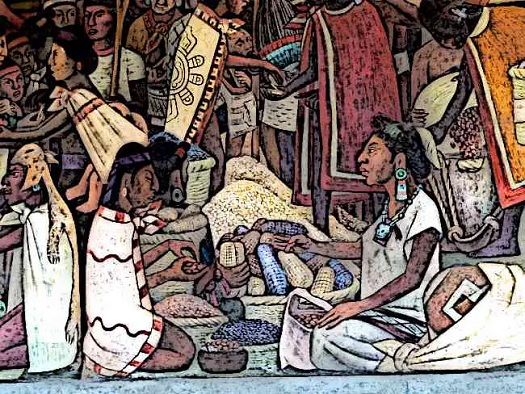
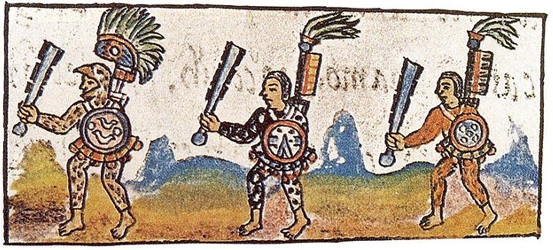
Here's a great article about the different parts
of Aztec civilization. Plenty of links to more
specialized pages. There is a great deal to
learn from these ancient people who built
a thriving society.

Commander Ernest Edwin Evans, USN, Medal of Honor, WW II


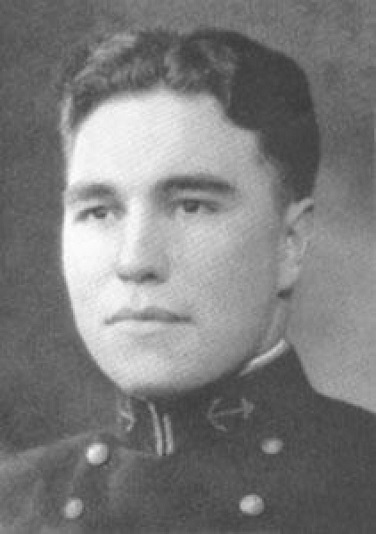
"THIS
IS GOING TO BE A FIGHTING SHIP. I INTEND TO GO IN HARM'S WAY, AND
ANYONE WHO DOESN'T WANT TO GO ALONG HAD BETTER GET OFF RIGHT NOW!"
CDR Ernest E. Evans, USN Commanding Officer, USS Johnston (DD 557)
Medal of Honor (Posthumous) Killed in action at the Battle
off Samar
He took on four Japanese battleships to save six little aircraft
carriers.
The other two destroyers and four small destroyer escorts came up
and attacked also. Anything to protect their carriers and keep the
enemy away from 200,000 American troops on the beach at Leyte.
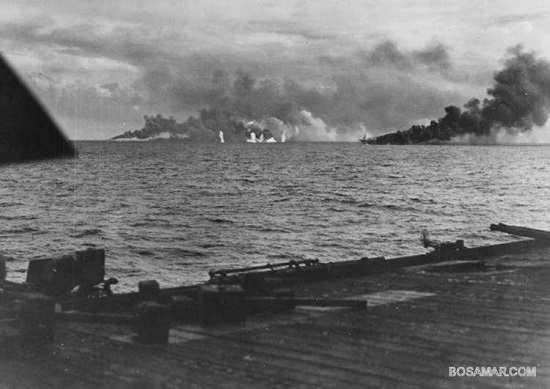
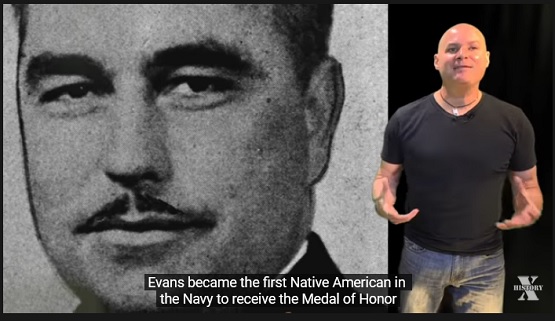
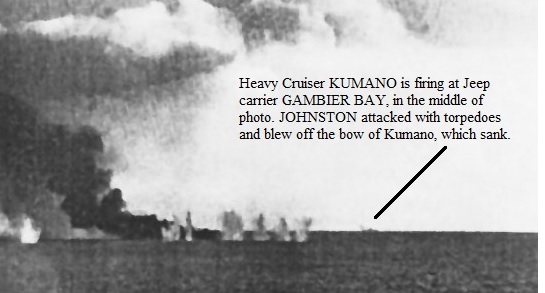
USS Johnston today. "557" still painted on her side. She sleeps
at the bottom of the Phillipine Trench. Lying more than 20,000 feet
(6,100 m) below the surface of the ocean, it is the deepest
shipwreck ever surveyed. This vessel is a War Grave, do not disturb.
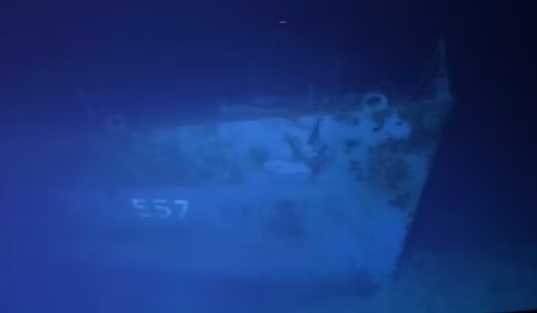
Johnston's twin sister Hoel
(DD-533) was also sunk in this fight,
as was Destroyer Escort Samuel
B. Roberts (DE-413).
Johnston's twin sister Heermann
(DD-532), was shot up
badly but didn't sink*, and survived the war.
Meanwhile, 23,000 years earlier...
Ice Age Footprints from PBS NOVA
Alternate URL: https://youtu.be/LS7ChlsZsGI
Ancient footprints provide new evidence of humans
and extinct giant beasts of the Ice Age. 53 minutes.
23,000 years ago! 11,000? years before Clovis points!
Until around 12,000 years ago, the great glaciers of
Canada and Alaska blocked off the North.
So how did these people get to New Mexico 10,000
years before that?

More links:
White
Sands National Park Footprints Offer Glimpse
into Life of a Prehistoric Mom and Child
Ancient
Footprints Push Back Date of Human Arrival in the Americas
NYT article
High
Country News article: "White Sands discovery only confirms what
Indigenous people have said all along. We have been here since time immemorial.”
Canada’s National
Indigenous Peoples Day, formerly called
National Aboriginal Day, is annually held on June 21 to
celebrate the unique heritage, diverse cultures, and
outstanding achievements of the nation’s Aboriginal peoples.
There are three Aboriginal groups in Canada – the First Nations,
Inuit, and Métis
peoples.
The Indigenous Rebel Who Took the Fight to White Settlers
As colonists spread across North America, Louis Riel took up arms
— and was demonized in Canada’s history books. After 150 years,
it’s time to reevaluate his legacy. This is an article from Narratively.
Authored by Julia Métraux. Louis Riel led the Métis
people of
Manitoba and Saskatchewan provinces. Constantly betrayed and
backstabbed by the Government of Canada, nevertheless he persisted.
Eventually he was hanged for treason.
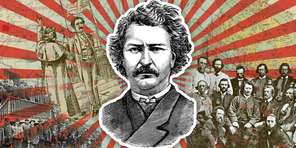
Happy
Native American Heritage Month From the
Army That Brought You the Trail of Tears
Native
American Heritage Day from Native
Hope
"We are on a journey to break down the barriers that have
threatened to silence the Native American voices that deserve
to be heard and acknowledged. We invite you to join us in
sharing inspirational stories of hope, love, power, and fortitude.
Stories of real people fighting to hold on to their heritage while
striving towards a future where their culture and their people thrive.
Mesa
ruins dating back hundreds of years
renamed to honor Native American heritage

Tribal members do ceremonial dancing on the
old temple mound.
Mesa Grande Cultural Park has a new name to better
reflect the property's deep roots to the East Valley's
Native American history. The cultural landmark will
now be known as Sce:dagi? Mu:val Va’aki, a phrase
meaning "Blue Fly's place of dwelling" in the O'odham
language. The site is home to a temple mound
believed to have been constructed starting in
A.D.1100. The village surrounding the mound was
once home to an estimated 2,000 members of
the Hohokam community.
Native History: How a Lame Cow Started the Plains Wars
The Grattan Fight: Prelude to a Generation of War
"A sick cow, a hungry Minniconjou warrior,
and a pair
of West Pointers had just ignited war on the frontier
of the Northern Plains."
The Army's revenge:
How Recovering
the History of a Little-Known Lakota Massacre
Could Heal Generational Pain (This long, detailed Smithsonian
article is worth your time.)
Expandable
map of the "battle" hand drawn by
Lt. G. K. Warren, Engineer. During the Civil War,
Major General Warren was the Hero of Little Round Top
during Day 2 of Gettysburg. There is a
statue of him on the top of the hill.
Captain Henry Heth was
also at Blue Water. He was
also at Gettysburg, also as a Major General, but on the
Confederate side.
After Blue Water, Warren collected things left
behind by
fleeing Sicangu Lakota women and kids (household items,
bloody clothes, baby clothes and other baby things, and
a toddler's little baby doll). and later gave it all to the
Smithsonian Institution. The idea of giving it back never
crossed any white person's mind.
The Lakota want it all returned. It has been a struggle
to pry the widely scattered items loose from bureaucracy.
This is all covered in the
Smithsonian article above.
Relentless
Indigenous Woman
Every child matters -
September 30th was the Day for Truth and Reconciliation,
also known as Orange Shirt Day.
If you’re an Indigenous ally, take this day [and every day] to learn
more about the historical and current realities of Indigenous Peoples.
For content on Residential Schools, visit the following sites:
https://legacyofhope.ca
https://nctr.ca/.../teaching.../residential-school-history/
https://education.afn.ca/.../learnin.../residential-schools/
https://www.baytoday.ca/more-local/orange-shirt-day-acknowledges-residential-school-system-2754355
https://www.kamloopsthisweek.com/entertainment/orange-shirt-day-originator-to-tell-her-story-through-childrens-book-4373498
-
#EveryChildMatters #ResidentialSchools
#TruthBeforeReconciliation
#OrangeShirtDay #MoreThanOneDay
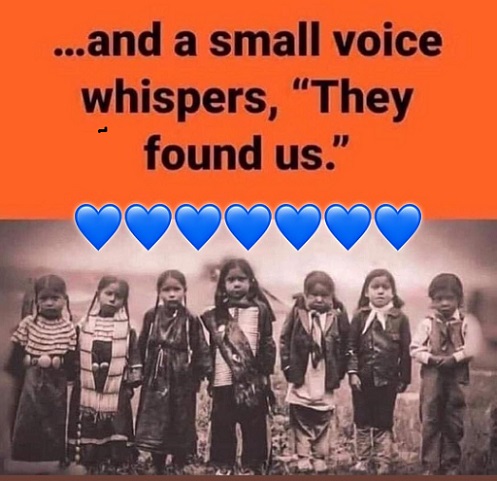
These little ones are still missing their mommies...
Their remains need to be sent home to their people.
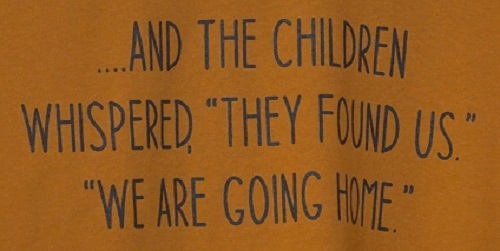
Orange Shirt Day originator to tell her story through children’s book
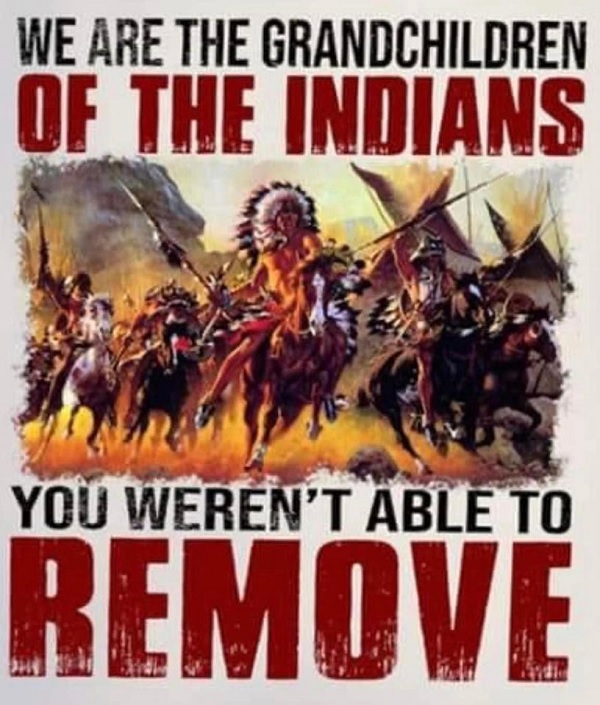
by Careen Keelin
·
Pontiac, born c.
1718, on the Maumee River now in
Ohio, died April 20, 1769, near the Mississippi River
at present day Cahokia, Illinois, was an Ottawa chief
who became a great intertribal leader. In 1763 he
organized a combined resistance, known as Pontiac's
War, to British power in the Great Lakes area.

We Are A Horse Nation -
short version
A documentary film that shares the voices of the Oceti Sakowin
(the Lakota, Dakota, & Nakota speaking tribal bands of the Great
Plains region), as they honor their relatives - The Horse Nation
(Sunka Wakan Oyate).
The government took our children
– to force them to forget who they were
This memorial is for them
– so they know we never forgot who they are
This memorial is for us
– so we never forget what they did
This land with the unmarked graves
was placed into
the trust of the Oglala, Cheyenne River, and Rosebud
Sioux Tribes to protect the graves of these children in
perpetuity, and these tribes have approved this
beautiful memorial to honor all our children.
Input was gathered for many years
for the memorial
– from the families of the deceased, descendants
of the survivors, THPOs, community members,
tribal leaders, elders, and spiritual advisers for this
simple and beautiful design.
The memorial is intended to be
a place of prayer,
gathering, and remembrance. The primary design
elements include a memorial walking path with
history boards along the route, individual boulders
with the names of each of the children who passed,
and four sculptures of traditional burial scaffolds
for children.
"So young, they took our babies away from us."

The
Aztecs One of 27 similar activities from Snaith
Primary School. Good graphics. Learn all about the Aztecs! Then try out
the story starters, quizzes, printables, Sunstone Puzzle, and coloring pages!
Daily Life of the Aztecs: A Blend of
Agriculture, Hierarchy, and Culture


Here's a great article about the diferent parts
of Aztec civilization. Plenty of links to more
specialized pages. There is a great deal to
learn from these ancient people who
built
a thriving society.
Blackfeet camp at night. Montana. 1800s. Glass lantern slide by
Walter McClintock.
Yale Collection of Western Americana, Beinecke Rare Book and Manuscript Library
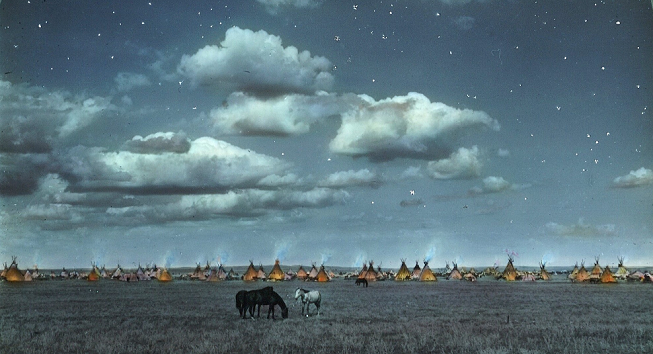
Blackfeet stampeding bison over a cliff, in the days before horses.
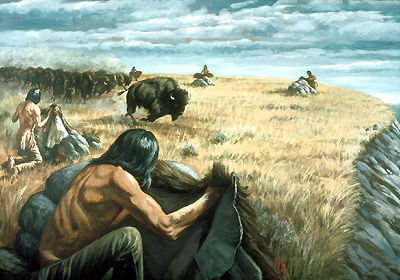
Gifts
of the buffalo. This graphic lists many of the gifts.
Not everything is listed, but the People used everything.
Waste not, want not.
Gifts
of the Buffalo Nation Learn about the North American
Buffalo
and their gift to the Indian Nations! By the Intertribal Bison
Cooperative, and the Wind
River Indian Reservation of the
Eastern Shoshone & Northern Arapaho.
This is a 31-page coloring book in pdf format, with plenty of
pictures to color and lots of facts about Bison!
From the original people of the bison comes this excellent educational resource. Learn the Traditional Uses of the Buffalo with a comprehensive printable .pdf chart. Learn why Buffalo Are Sacred. Learn buffalo facts, the Historical and Cultural Connection to the Buffalo and the awful Slaughter of the Buffalo. Find out about buffalo Meat & Nutrition, and recipes. Play the Buffalo Brain Busters game. Color in the Coloring Pages for Kids.
This is a mound of bison skulls
and other bones.
The idea was to kill off the buffalo so the Natives
who built their whole culture and way of life around
buffalo would come to the reservations, disarm, live
in white-style houses, learn to farm the white way, and
depend on government rations for their food. Oh, and
send their children to boarding schools to be changed
into good citizens who spoke English only.
After the buffalo were gone, ranchers moved cattle
in and started the cattle industry.
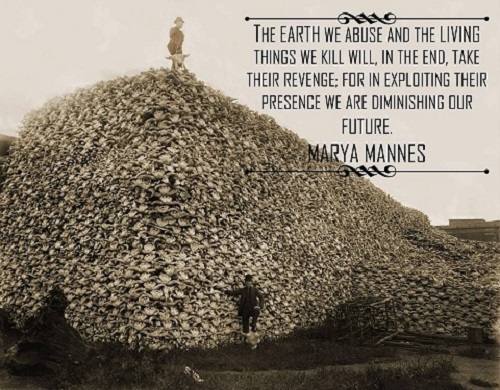
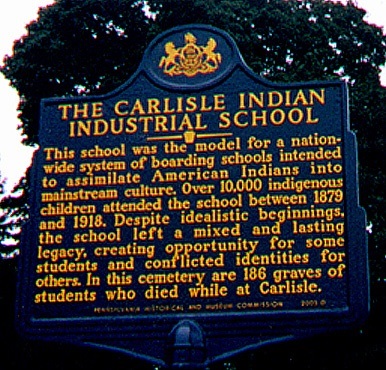
A moment of silence for the children who died in this awful place..
In the USA, Native Americans of both genders got the right to
vote in 1924,
when they officially became citizens. It took until 1948
for all the states to
finally let most Native people vote. The last state to fully guarantee voting
rights for Native people was Utah in 1962.
"Identity by Design" is no longer online.
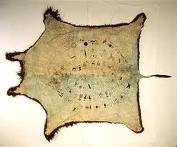 LakotaWinter Count Activity for kids- An online exhibit from the Smithsonian. Who are the Lakota?
What's a Winter Count? Who made them? What art media were used? Walks kids through making their own winter counts with their own families.
LakotaWinter Count Activity for kids- An online exhibit from the Smithsonian. Who are the Lakota?
What's a Winter Count? Who made them? What art media were used? Walks kids through making their own winter counts with their own families.
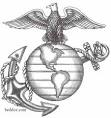
Minnie
Spotted Wolf This tough, 5'5" (165 cm) ranch hand from the Blackfoot
Nation in northwest Montana set fence posts and broke wild horses before joining
the US Marines in World War II. She was a heavy equipment operator, a truck
driver, and a mechanic. When the war was over, she went home and taught school
for 29 years, raised four kids, and kept working on the ranch. She could outride
the young men of her people into her 50s. "Mom
was proud of who she was. She wasn't in the military just for herself, but for
the Indian people. She wanted others to know who she was and where she came
from." Another hard-working, honest, no-nonsense Native
woman.
Molly of Denali is a cartoon
on PBS Kids. This site
has games, videos, activities, podcast, and an app.
All in the context of and told from the pov of the
Gwich'in people. The
Gwich'in live in Canada and
across the border in the US. They are one of many
related groups that make up the Athabaskan
peoples. Almost all of them, from Gwich'in to
Navajo, call themselves Dene, Dineh, Dena'ina,
Diné, or something similar. Dene means "the people"
"people who talk like us". Molly and her friends
and relatives on the show are careful to teach
the importance of families, respect for elders
and traditions,looking out for one another,
putting everything back in its place, respect
for Nature (especially winter), only taking as
much as you need - be it plants, fish, caribou,
rabbits... Gwich'in are known as the Caribou People.
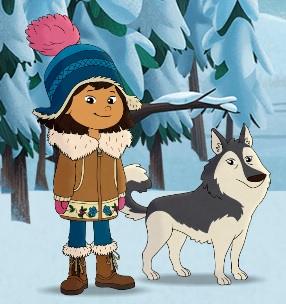
Molly's Winter Kitchen
Help Molly
and her mom preserve food for the
winter. You use an ulu knife
for
cutting meat and veggies. You may
have to borrow items from others
in your community (meat, firewood)
because people look out for each
other. This is an interactive activity,
one of many at the site.
The
sacred 'sisters' of ancient America
from BBC World's Table
"In Quebec, the tale of the "three sisters" isn't just
a myth about cooperation; it's a message from
Wendat ancestors that teaches modern people
about ancient, life-sustaining food."
.jpg)
and a great video:
Three
Sisters: Companion Planting of
North American Indigenous Peoples
10:53 video from GRIN-U Education
.jpg)
Moundbuilders
Teacher's Guide for Native American Heritage Month. From the American Indian
Cultural Center and Museum (AICCM) of Oklahoma. Excellent self-contained teaching
unit ready to go! Amazing art, artifacts, in-depth discussion of various moundbuilding
Native American cultures over 11,000 years, from prehistoric times to the 1500s.
Lots and lots of art! Plenty of activities.
Native Americans and the U.S. Military Gives the history of Native Americans in all branches of service during the past century. Also lists the eight Native American Medal of Honor winners from World Wars I and II, Korea, and Vietnam. Information about Code Talkers of different nations.
Native Americans in the US Army Lots of links, videos, biographies, a Comanche Code Talker, and more. Includes Willing to Serve, a cross section of Native veterans and active-duty.
Native Americans in the US Navy Primarily about World War II, Korea, and Vietnam. Biographies of famous Native sailors, including Commander Ernest Edwin Evans, USN, Medal of Honor, WW II. Also a nice PowerPoint about Native sailors past and present, including a Navy Seal Medal of Honor winner from Vietnam.
Watch this video about John C. Waldron!
Lt
Commander J C Waldron, USN. Commander, Torpedo
Squadron 8,
USS Hornet (CV-8). Navy Cross (Posthumous). Killed
in action, Battle of Midway.
Graduate of Rapid City High School, Class of 1920; US Naval Academy, Class
of 1924. His mother was Oglala
Lakota. She taught him the traditions of
The People. He grew up on a ranch near Pierre, South Dakota.
Commander Waldron knew his 15 old and slow aircraft stood zero chance against
the fast and nimble Japanese fighters that would try to stop them. He told his pilots:
"I want each of us to do his utmost to destroy our enemies.
If there is only one plane left, I want that man to go in and get a hit.
May God be with us all. Good Luck, happy landings, and give 'em hell."
All of Torpedo 8's planes were shot down. Only one man survived.
It wasn't LtCdr Waldron, it was a young pilot.
Lest We Forget
![]()
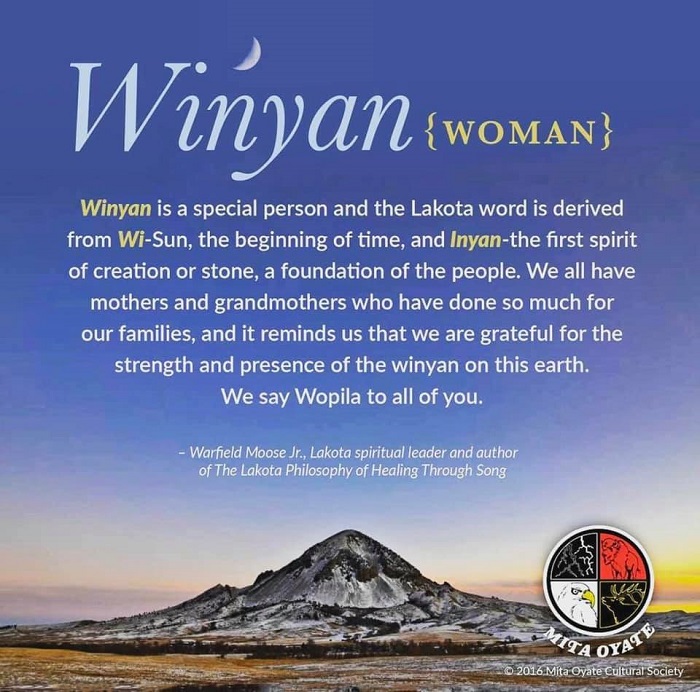
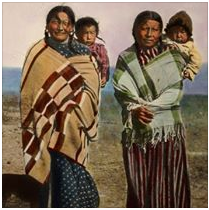 Old
Color Photos of Native Americans collected by Paul Ratner "While making
Moses on the Mesa, a film about a German-Jewish immigrant who fell in love with
a Native-American woman and became governor of her tribe of Acoma Pueblo in
New Mexico in the late 1800s, I developed a passion for researching old photographs
of indigenous people... Please enjoy this first collection of colorized photos.
If you like them, you can find many more at our
historical and photographic archive on Facebook." Click the link or
log on to Facebook - Moses on the Mesa.
Old
Color Photos of Native Americans collected by Paul Ratner "While making
Moses on the Mesa, a film about a German-Jewish immigrant who fell in love with
a Native-American woman and became governor of her tribe of Acoma Pueblo in
New Mexico in the late 1800s, I developed a passion for researching old photographs
of indigenous people... Please enjoy this first collection of colorized photos.
If you like them, you can find many more at our
historical and photographic archive on Facebook." Click the link or
log on to Facebook - Moses on the Mesa.
Let's Get 'Sirius' About the Dog Star, Sky's Brightest Twinkler from Indian Country Today Media Network. Facts about Sirius, but mostly tells how the star was regarded in Native American/First Nations cultures and in the myths of various tribal nations. Very good reading. If you don't see the star's photo on their site, click on the graphic.
![]()
Fallen Yet Not Forgotten -
Remembering Pascal Cleatus Poolaw, Sr., the most
decorated Native American soldier in U.S. history.
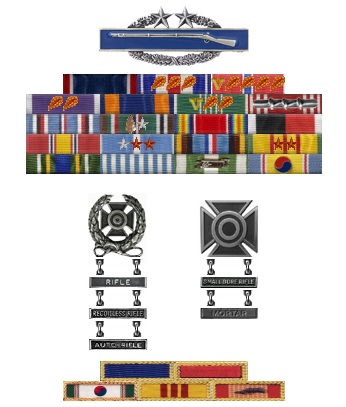
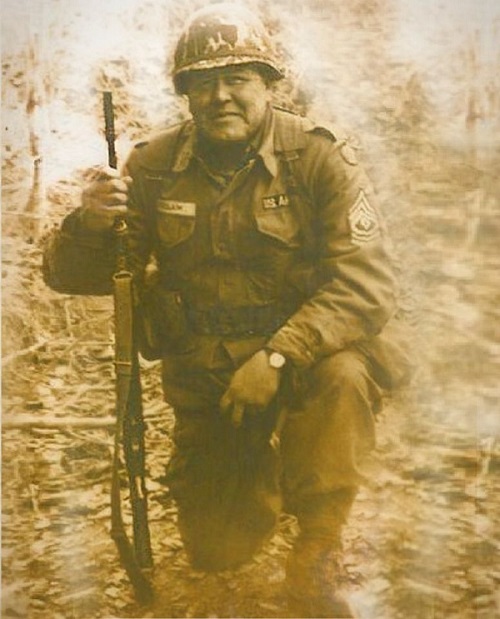
Remembering Pascal Cleatus Poolaw, Sr., the most decorated Native American soldier
in U.S. history - 4 Silver Stars, 5 Bronze Stars 3 Purple Hearts. He earned
a total of 42 medals and citations.
Born on January 29, 1922, in Apache, Oklahoma, Poolaw, a full-blooded Kiowa,
served with the United States Army in World War II, the Korean War, and the
Vietnam War. Poolaw, his father and two brothers joined the Armed forces in
1942 during World War II. He earned his first Purple Heart when he was wounded
in September 1944. While serving with the 8th Infantry Regiment's M Company
near Recogne, Belgium, Poolaw's unit was engaging fire with the Germans. He
pushed his unit forward under heavy fire and hurled hand grenades at enemy machine
guns, causing numerous enemy casualties and as a result of his heroic actions,
many of his comrades lives were saved and the company was able to continue the
attack and capture strongly defended enemy positions. Poolaw's military career
did not end in Belgium or with Germans. During the Korean War, Poolaw saw combat
and was wounded again and awarded the Distinguished Service Cross, a second
Purple Heart, and two more Silver Stars.
He returned to the U.S. in 1952 and retired from the Army ten years later. This
is not where his military career ends.
During the Vietnam War, all four of the Poolaw's sons were in the military.
In February 1967, his son, Pascal Jr., was injured by a landmine in Vietnam.
This injury resulted in amputation of his right leg below the knee. Poolaw’s
youngest son, Lindy, was also drafted. Afraid of what could happen to his sons
as the war progressed, Poolaw rejoined the Army at the age of 45. Giving up
his rank as a 2nd Lieutenant (a promotion he earned in Korea), with the intentions
of serving in direct combat, Poolaw hoped to keep his youngest son away from
the front lines by taking his place. Regulations prohibited two members of the
same family from serving in combat at the same time without their consent. Unfortunately,
by the time he arrived on the West Coast, Lindy had left for Vietnam the day
before.
Poolaw was deployed on May 31, 1967 as a first sergeant of the 26th Infantry
Regiment's C Company. His last Silver Star was for an event that occurred a
few months later. On November 7, 1967, Poolaw's unit were part of a search and
destroy mission near the village of Loc Ninh. Poolaw and his unit were ambushed
by the Viet Cong force with intensive claymore mine, rocket, small arms, and
automatic weapons fire. While wounded, he continued moving among his squad making
sure everyone was positioned properly while pulling casualties back.
As Poolaw was carrying a wounded soldier to safety, he was struck
by a rocket propelled grenade and killed. For his heroic actions Poolaw was
awarded a Silver Star and a third Purple Heart posthumously. " He
has followed the trail of the great chiefs," his wife Irene said
at Poolaw's funeral. His people hold him in honor and
highest esteem. He has given his life for the people and the country he loved
so much."
We honor and thank First Sgt. Pascal Poolaw Sr. for his exemplary service and
the ultimate sacrifice he made for our country. Rest in peace good warrior.
You will never be forgotten!!
Trail
Of Tears Official title: "The Trail Of Tears: Government-Approved Ethnic
Cleansing That Removed 100,000 Native Americans From Their Ancestral Lands"
By Daniel Rennie, in All That's Interesting.
"The Trail of Tears refers to the perilous journey of the 'Five Civilized
Tribes' of the Southeast who were forced by the U.S. government from their ancestral
homelands to a designated zone in the west." Plenty of graphics, maps,
and pictures detail the Indian Removal Act. "up to 100,000 Native Americans
were relocated and over 15,000 lost their lives". They also lost their
homes and their property.
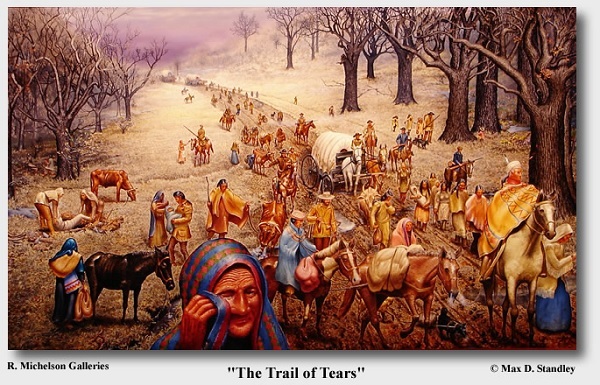
![]()
“Whose Land Do You
Live On?” Reminds Americans Colonization
Happened in Their Backyards
First Peoples populated America long before Europeans arrived
to stake their claim. We have largely forgotten this legacy.
A mapping tool is looking to change that.
Wounded Knee Massacre Survivors - credit = Indian Country Today
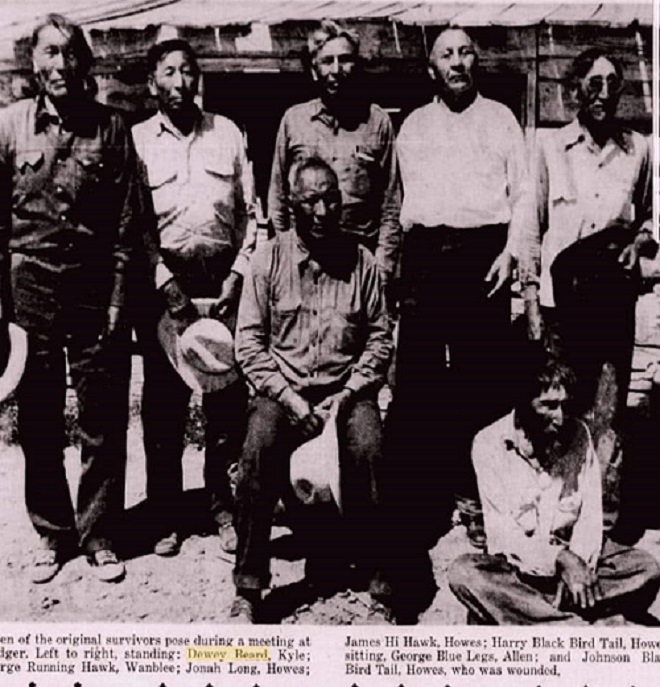
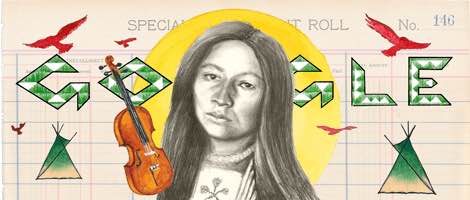
Thanks to Gene Swallow, Lakota artist
·
Today’s Google Doodle
All of the elements in the artwork relate to Zitkala-Ša’s life in
some way.
Her Nakota name translates as “Red Bird,” she wrote an opera relating
to the Sun Dance, and she was an accomplished musician—all reflected
within the Doodle. She also witnessed great upheaval and change
throughout her life, as symbolized by the tipis. The lettering for “Google”
is based on a beadwork design from one of her traditional dresses.
— Chris Pappan

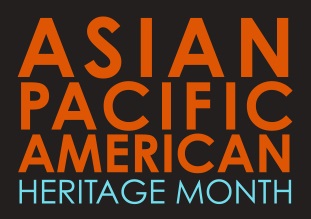
begins here!
The dark history of the overthrow of Hawaii
On January 16th, 1895, two men arrived at Queen Lili'uokalani's
door,
arrested her, and imprisoned her. The Missionary Party had recently
seized power and now confiscated her diaries, ransacked her house,
and claimed her lands. Lili'uokalani was Hawaii's queen and she
ruled through one of the most turbulent periods of its history.
Sydney Iaukea shares how the ruler fought the annexation of Hawaii.
![]()

![]()
A Brief, 500-Year History of Guam from Smithsonian
"The Chamorro people of this Pacific island
have long been
buffeted by the crosswinds of foreign nations"
Including the natives of the Northern Marianas.
![]()
American
Samoa The other American Polynesian islands
![]()
![]()
Learn about the National Park of American Samoa
![]()
Japanese Internment Camps from
history.com
America's Concentration Camps and memorials to
the racism that is still part of America. Thousands
of Americans were put in prison camps for years!,
for the crime of picking the wrong ancestors,
and not being white. Of course, their homes and
businesses were taken away from them and given
away to white Americans. This is a long
article with plenty of well-organized information.
![]()
How
Two Japanese Americans Fought Nazis Abroad
—and Prejudice at Home
A story about of America’s 442nd all-Nisei Regiment.


![]() to top of page
to top of page ![]()
![]() to Good Sites!
to Good Sites!
Powered
by ![]() The World's #1 Web Host
The World's #1 Web Host